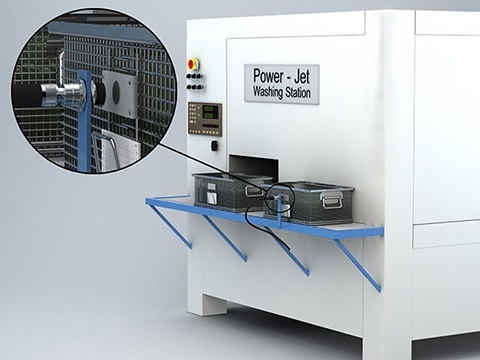
Posted to News on 30th Jun 2025, 09:40
Robust RFID prevents washing machines getting in a spin
A manufacturer of industrial workpiece-carrier systems trusts Contrinex's robust RFID (Radio Frequency Identification) technology to identify component baskets and initiate automated in-process washing.

(See PLUS Automation at FoodManufacturing.Live, 15 October 2025, on stand 48)
A read-write module, mounted at the washing station, interrogates the nylon-encased RFID transponder tag on the approaching carrier. The customer's control system identifies the carrier and initiates the correct washing cycle.
The manufacturer of automotive components needed to wash components at several stages of the manufacturing process. It wanted to automate the production cycle so that batches of components, loaded in custom-designed, metal basket carriers, could travel between process stations in an unordered sequence. As each carrier approaches the washing station, the control system would automatically select the correct washing cycle for the batch.
The modular design of the metal basket carriers enables them to transport multiple types of components. Each basket accommodates a variety of inserts, each tailored for a specific component. The identification system must allow component data to be stored temporarily and rewritten for each batch, as a carrier is not always used for the same component.
The production environment is harsh. RFID transponders and read/write modules are exposed to hazards that include mechanical shocks, hot water, corrosive chemicals and high-pressure jetting. Identification systems must operate continuously in this environment with ultra-high reliability.
Contrinex RTP-0501-000 RFID transponder tags were selected for use. While being only 50 mm in diameter, the IP67-rated transponders offer read/write distances of up to 42mm, depending on the selected read/write module.
Each basket has the RFID transponder mounted in a holder attached to its side. Tags, which clip into the holder, are interchangeable, with IP67 or IP69K-rated versions are available. At the start of the production cycle, the transponder is programmed with information including component part number and batch ID.
Read/write modules on process stations, read the tag on each carrier. In an automotive manufacturing plant, various types of components are processed sequentially at the washing station, where the information from the RFID tag is used to select the appropriate washing cycle for each batch.
On completion of the production cycle, parts are unloaded from the carrier. The customer's PLC control system checks the tag data against the expected value and then overwrites the data on the tag in preparation for the next batch.
Contrinex ConIdent RFID devices enable unordered process sequencing and provide excellent service life, reliability and robustness that are lacking in alternative identification systems.
Want the latest machine building news straight to your inbox? Become a MachineBuilding member for free today >>















